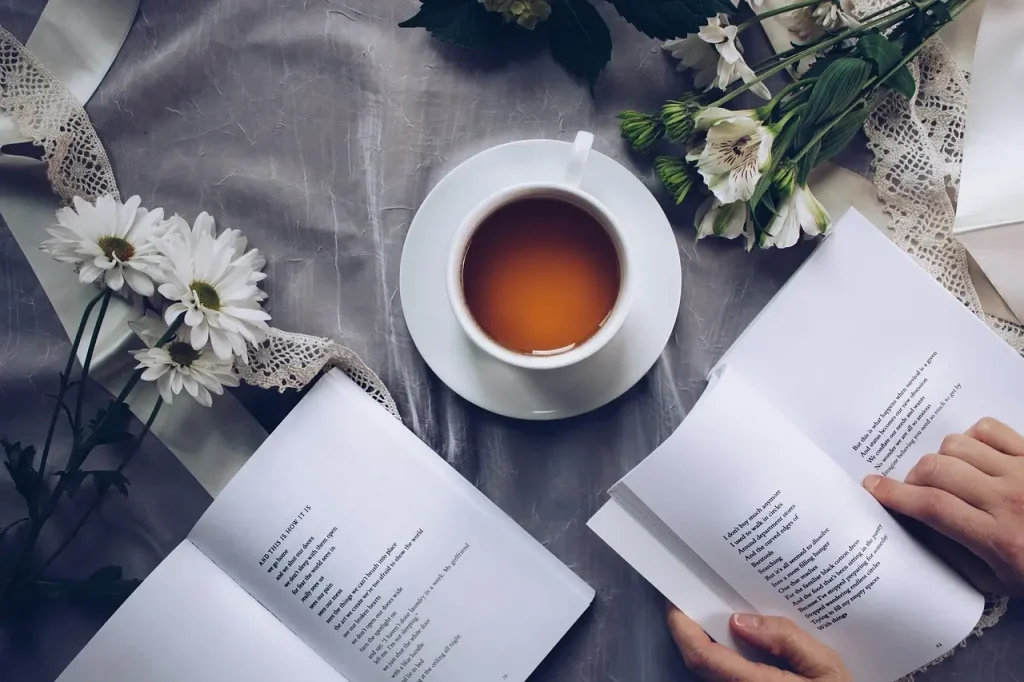What’s so important about learning to read better? Reading is the key that unlocks doors of knowledge and self-discovery – helping you learn new things, grow wiser, and broaden your view on life. But sometimes we get overwhelmed, or our brains don’t make sense of what we read easily. This article explores ways to improve efficient reading for personal growth engagingly. We dive into various strategies that can enhance your comprehension while ensuring you enjoy every book – no matter its subject, size, or genre!
Understanding how to read smarter and faster without losing depth will give a significant boost in everything from studies and career advancement to improved problem-solving abilities. We’ll break it down into easy steps so everyone can improve their reading game for more personal growth. Let this learning journey take your love for books to an even higher level!
Developing a Strong Reading Habit and Routine
Readying your mind to fully immerse in reading can feel like getting ready mentally before hitting the library. How do you create an effective habit for engaging with books frequently, enhancing understanding and retention? Follow these tips: Establishing a conducive environment plays the same role as creating optimum study conditions; having easy access promotes frequent practice, just as stocked kitchen cabinets encourage regular cooking!
Start small but steady by carving out 15 to 30 minutes, gradually increasing reading time – like getting comfortable with exercises before building up stamina. Combine it alongside other routines and commitments (e.g., pre/post work), embedding the habit in your daily life, just as exercising does!
Prioritize genres you enjoy; if cooking is fun for some, choose reading types that excite – nonfiction or fantasy might be yours. Reading what captures interest helps establish a solid base to build upon. Remember, it isn’t about quantity but quality time with words in your mind – just as listening and absorbing lecturers!
Reading aloud at first can help absorb content better, similar to pronouncing unfamiliar vocabulary enhances understanding; then move into quieter internalizing once you get the hang of things. And don’t be too hard on yourself if distractions occur – remember it’s a learning journey like any other!
Join or form reading clubs for accountability and social interaction, similar to team sports helping people stay consistent in practice; sharing experiences boosts engagement, making habit-forming even more fun than solitary routines. And finally… just do it as often as you can – no fancy technique is required sometimes; only willpower is needed! Remember, it’s all about forming that reading routine for better comprehension and understanding, similar to how daily exercise improves fitness over time with consistency – so give yourself a chance at enjoying books more frequently.
How to create effective goal systems for regular and sustained book readings.
Developing any good habit is all about making it easy and enjoyable. When talking specifically about cultivating a solid reading routine, here are key guidelines to consider for both short-term successes and long-lasting impact:
1) Set realistic goals; small steps toward big achievements will keep you engaged; think ‘a book per week’ instead of yearly targets!
2. Motivate yourself with rewards, and make it fun – who doesn’t like treats? Use incentives to stay energized during a tough read (or easy one), or join reading clubs for community encouragement, just as athletes do in training groups; keep that bookworm spirit alive through peer motivation!
3. Diversify your selections and genres – no need to get bored with repetitive themes/authors – it’s like eating the same meal every day: unhealthy mentally & physically, right? Read varied content for rich mental nourishment (like how you might mix up what’s on a plate).
4. Designate reading time in your daily routine – similar to setting fixed gym sessions, block out certain hours/minutes when possible, just like ‘reading class’; this helps create consistency, and eventually, the habit sticks as firmly as second nature!
5) Find suitable spaces for ‘quietude’ – be it a cozy nook or public library – making your reading zone comfortable is critical to sustaining that routine.
6). Last but not least, share insights with peers about what you’re enjoying and discovering in books; discuss perspectives & ideas, enhancing the overall experience of ‘readership.’ Establishing a strong bookworm habit comes from small steps taken consistently over time through proper goal setting coupled with strategic motivation approaches!
How can readers strike a balance between leisure and informative reads for better learning in various settings while managing their reading habits?
For those trying to cultivate a solid bookworm lifestyle and absorb information from various sources, the challenge is managing time. It’s about finding a balance between leisure, self-betterment reading materials (think nonfiction or personal development books), recreational reads like fiction novels – all while working around your day job!
Create a schedule that factors in both work and play; it helps you allocate specific hours for each task. This includes setting aside time to read consistently every week/day – aiming towards 15-30 minutes daily might be a good starting point (like brushing teeth!). Incorporate variety into your routine – mix business books with fiction, keeping that reading life spicy and interesting!
Next level up? Join or create a book club where you can interact while broadening perspectives. It keeps us accountable as we discuss ideas together on what’s read (and munch some snacks too). Don’t forget to mix digital resources with real paperbacks – they both bring unique benefits, but remember that screen time might sap focus for lengthier reads, so physical books could be better in certain cases.
Donate or lend out completed titles; this helps clear your reading space and offers others the chance at new adventures! This fosters a sense of community within readers’ circles too – win-win situation all around, right? By following these steps, you build that strong, sustainable habit we crave – like learning to ride without training wheels. Happy Reading, y’all!
How to establish regular, effective reading habits?
Just like how we have our morning cup of coffee or evening yoga session, building strong reading habits can become an everyday ritual. Consistent daily practice is the key to forming a beautiful habit that feeds your mind and soul with knowledge – so here are some practical steps:
1) Find “me time”: Allotting specific moments each day for personal pursuits like browsing pages will help it feel important, unlike tackling reading randomly. Aim at consistency rather than trying to read a novel daily, as this gives flexibility if you skip one or two days occasionally, but your average remains consistent over the week and month.
2) Set realistic goals: Be reasonable about how long each session lasts – an hour could be ideal, though it may vary with time constraints. This will avoid feeling pressured, which defeats the purpose! Begin small, then build gradually as you progress in reading pace or interest grows for a more pleasurable experience.
3) Create “reading corners”: A dedicated space to read makes the habit feel special – like having your own library nook at home.
4) Read what interests you: Seek books that align with personal passions, whether fiction/non-fiction. Your enthusiasm will make it easier and more enjoyable every time you open a book, thus fueling this routine further.
5) Track progress: Keep track of how much reading has been achieved daily or weekly to stay motivated about your goals.
6) Incorporate reward systems: Reward yourself once the set target is met. This could be anything from taking a nap to playing an episode on Netflix (for a day’s worth), etc., making it even more enjoyable!
7) Make reading social: Read with friends or join book clubs to add another layer of fun.
Skillful Speed-Reading Techniques with Comprehension Retention Methods
How do pauses impact speed-reading effectiveness, comparing SQ3R & SKCR methods in comprehension retention? Let me break down the crucial differences between various speed-reading methods, like SQ3R vs. SKCR – all with comprehension in mind! You know how we learn at school? Some teachers use this awesome method called “Survey, Question, Read, Recite, Review” (aka ‘SQ3R’) where you stop every few pages to make notes and questions that help retain the info later on, like having a cheat sheet for remembering. This technique boosts reading speed while improving comprehension!
But there are others – Speed-Reading Keys Cycle Rhythm (SKCR) speeds up by focusing solely with your eyes instead of full scans; it claims faster recall but could impact the depth of understanding due to a lack of active engagement or visual reinforcements. Then you have the Power Reading method, which is like a hybrid blending speed and comprehension – kind of SQ3R on steroids!
Pauses are vital too…imagine stopping every 10 pages for breaks in your reading marathon; it gives the mind time to rest but also process what’s been read so far. This breathing space could significantly improve absorption, making comprehension a breeze while increasing speed without sacrificing understanding (SQ3R pauses and SKCR rhythmic breathers are good examples).
In short: compare these techniques for your unique learning style – find the one that clicks! And don’t forget those all-important breaks. So read on, but do it smartly with an eye to comprehension too; you might be amazed by how much faster and better at retaining knowledge you can become over time (kind of like when we studied for exams – some took notes in the margins while others just raced through…guess who ended up on top?)
How do pauses impact speed reading in techniques like SKCR and The Power Method?
First off, let’s talk about that crucial part of reading – pausing! Pauses play super important roles when using techniques like SQ3R or The Power Method, which are all aimed at helping you read faster while still understanding what’s going on. These breaks help in absorbing info better and not overloading your brain with too much stuff quickly (just as a chef would stop between chopping veggies).
In the case of SQ3R: “S” stands for surveying, followed by question-asking (“What?”), reading thoroughly (‘Read’), then review. Pauses are essential during ‘read’ – stopping helps process what you just read and get the big picture! This balance is key to mastering these techniques (like finding the perfect recipe).
As per The Power Method: it too demands pauses, mainly in its four-step cycle of Preview (‘P’), Questioning yourself (“Q”), Reading deeply but briefly every 75 words or so – that’s like checking on the stew. This ‘Rhythmic Paused Comprehension,’ aka “PRC,” is what makes this method different and potentially faster in aiding comprehension!
These two popular speed-reading approaches (SQ3R, Power) have pauses as crucial ingredients to retain info while reading fast. The SQ3R’s ‘Read’, or your full concentration on text for a few seconds before moving ahead, is vital – just like not rushing through dessert! In the case of “The PRC” approach within the Power method cycles (pausing after every 75 words), it resembles cooking in portions. Both aim to balance speed and comprehension, making reading easier on our minds but also efficient for getting more done faster with less fatigue – pretty cool if you ask me!
Utilizing Highlighting Strategies for Key Points and Recall Enhancement
Increasing efficiency while reading can be a game-changer, especially when it comes to remembering vital info. That’s where highlighting strategies come in! By pinpointing significant bits and organizing them visually or digitally on paper/screens (whichever suits you), we improve the retention process dramatically – think of this as your personal study session booster pack for lifelong learning bliss!
First things first, understand why highlighting helps: It aids in categorization. Divide into major themes by color-coding or separate categories altogether; that’s like organizing recipes from different cuisines to find them easily when cooking up something special later on (see how it all connects?). Then comes the actual act – which bits need attention can be noted without hesitation, turning reading time more focused.
Recall boosting: Since highlighted words pop out while skimming back through pages/screens with our eyes trained to search for those bright hues or bold fonts we chose earlier (it’ll become a habit), this triggers recall easier than if everything was just in one shade, right? It’d be like finding the red sauce on pizza vs. brown cheese – so obvious!
Beyond reading: The same strategy can also apply to other media consumption – TV shows/movies etc., where key scenes could pop with an identifier (like a post-it note), allowing for deeper insights and easier recall later, even in years ahead when life takes unexpected turns we’d wish not forgotten. So embrace highlighting – let that color your reading!
When should you revisit highlighted passages for better retention?
Okay then! When we’re talking about “highlighting for success,” timing is critical – kind of like having an amazing idea but keeping it to yourself if you miss the best moment. Here are some guidelines that could help: first, know your purpose in highlighting (are they notes or just cool quotes?). Then pick a frequency depending on your learning style and memory patterns!
If retention is tricky for you, frequent touchups may be better than spaced out – think of it like nourishing seeds instead of single rainfall. For others, taking time between highlights can enhance recall later (like giving them some space to grow). So test different timings and see what works!
Have a clear method when using highlight colors or styles: maybe blue for key concepts & pink marks questions needing research – consistency in organization could really help keep it all organized. Remember, the right timing will depend on each learner’s style; finding your groove is like mastering that one song you love dancing to! So go forth and conquer highlight land with confidence…and maybe a nice color-coded key ring for easy access?
How to optimize notes with key point highlights for better memory recall?
When it’s all said and done with our books or important articles – we want to remember those key points for future reference, right? Highlighting text can help us absorb more information during study sessions. Here are some top techniques that boost recall by focusing on essential takeaways:
1) Organize thoughts before starting- Decide the purpose of reading (memorizing dates or understanding a theory). This shapes your highlight strategy – like how you would use different colored highlighters to mark distinct themes in one text. It’ll help streamline and consolidate our learning later on, which boosts retention rates!
2) Break it down- Try breaking the content into smaller chunks before tackling an entire book or article at once; this helps focus attention better while highlighting critical information effectively without feeling overwhelmed by details that may not be essential for your needs. This chunked method also allows a natural break in case of distractions, which can happen to anyone!
3) Reflect & Review – After reading through and making those color-coded highlights (or electronic ones if using digital copies), reflect on what you’ve highlighted; this self-reflection helps solidify the main points. Then review your notes at regular intervals for maximum retention before exams or presentations, kind of like studying a map to find treasures within!
4) Test Yourself- Don’t just rely solely upon highlights during revision time – actively test yourself on what you’ve highlighted by doing mock quizzes. This will help boost your memory recall and solidify the points further in those neural pathways, making retrieval more efficient come exam or presentation day!
5) Involving Different Senses- Make it an immersive experience when learning – add auditory notes (recordings), visuals where possible to connect with all senses; this aids retention by involving multiple brain regions in the process. It’ll help your mind stick better, especially for those tricky points!
How can color-coding improve reading efficiency?
To ace memory games and academic tasks like exams that require absorbing lots of information, many turn to highlighting key points. Here are some must-know techniques for effectively using highlights in your study routine:
1 – Choose a color code system based on subjects or types (either predetermined/custom). It helps distinguish and categorize concepts effortlessly when reviewing later!
2a) Use different shades of the same base highlight to indicate related ideas, allowing quick visual connections. If you’re using distinct colors for each subject area though…keep consistency within that particular topic (example: all History lessons in Red while Science remains Green).
3 – Avoid overusing highlights as too many might blend together and lose significance later when needed the most! Try limiting to essential points, main themes or transition phrases. Remember one doesn’t necessarily need color for every sentence of a textbook chapter either…just focus on key ideas that stand out in your reading process (perhaps even re-reading sections you don’t catch).
4 – When preparing flashcards/notes from highlighted texts; write down only the essentials, leaving highlight codes intact. This lets both visual and written notes help solidify knowledge while retaining organization of key ideas for recall purposes!
In a nutshell: color coding is your secret weapon when studying but remember to apply with care & strategic thinking in mind – don’t drown critical info under rainbow chaos!
Reading Different Genres of Text Effectively (fiction vs non-fiction; academic books vs news articles etc.)
Let’s understand reading different texts and genres better! Some folks might stick with one type – let it be fiction or non-fiction, academic books over news articles. But why not venture out? After all…the literary world is richer than a single cuisine buffet: there are multiple dishes to relish (even within these categories) that offer unique flavors for different appetites!
Recognize genre traits and adjust reading styles accordingly, like learning what knife best cuts the steak from sashimi. Fiction demands imagination; non-fictions call upon analytical skills or current affairs grasp – a bit tricky to shift gears in mid-read? Practice helps develop versatility!
Academic books require close scrutiny – highlighting, taking notes… just like cramming for that big exam you once dreaded. News articles are time-sensitive; digest them quickly but critically as they offer a fast food menu of the world’s updates – no need to linger unless it’d help make an informed decision!
Then there is poetry, which requires emotional engagement rather than just consuming facts or following plots: your inner senses guide you through its language dance. And graphic novels combine visual storytelling with written text – a perfect union for those who relish the art of reading in multiple ways (or struggle to read long texts).
In essence? Read widely and adapt our approaches – enjoy this rich feast called literature, where no genre holds all answers; we’d miss out on so much without it.
How to optimize learning by adapting techniques for different genres?
Diving into the world of diverse books is like traveling from one culture to another. But as you pack your book bag, remember that every journey demands a different strategy – fiction requires its own methods than non-fiction or academic texts do! So let’s explore how best we can conquer these literary genres without losing our minds (or the plot) along the way:
Fictional stories often have twists and turns like rollercoasters. Pay attention to character development, which drives their emotional journeys in narratives – think Harry Potter or The Fault In Our Stars here! For news articles…well they’re kinda “now” sense-making tools for current affairs: focus more on main ideas as events happen quickly; don’t get lost chasing rabbit holes like you would with fiction.
Academics are quite a beast too – it takes time to tame them (like those heavy textbooks that haunted our school days!). Think about their structures and referencing styles: they’re dense but orderly, so stay organized when reading these books or journals – jot down key points & cross-check references.
News articles again call for speedier reads; grabbing the main idea is crucial since news changes rapidly – like chasing a fast train! Non-fiction works (academic/journalistic) often demand careful scrutiny, so read them with an investigator’s mindset: look closely at their argumentation and evidence.
So remember these genre-specific reading techniques; your literary journey will be more enjoyable as you adapt to each new book adventure!
How do we adapt reading techniques for fiction versus non-contextual data in academic and real life?
When it comes to reading different genres – like novels versus news articles or textbooks – our brains need slight tweaks in strategy. These texts have varying goals, so we must adjust how they’re digested for best comprehension and enjoyment!
With fiction books (think Harry Potter), focus on immersion: the world-building is key to living each character’s journey alongside them as it unfolds within its pages – sort of like walking through an imaginary landscape. Here, reading should feel almost dreamlike – letting ourselves be carried away by rich language and captivating characters!
In contrast with academic or non-fiction texts (think news articles), the aim is more analytical: understanding facts objectively; focusing on sourcing information to construct a sound argument from credible evidence. This process requires sharper focus, often skimming for critical details – similar in some ways to taking notes during class!
For textbooks or scholarly materials (like your Chemistry lecture), learning retention is vital – the goal here isn’t just understanding what you read now but remembering it later too; that calls on strategies like summarizing main points and employing active recall. It’s almost a mental exercise in muscle memory, allowing ideas to flow smoothly from brain-to-fingertips!
So whenever diving into any text – whether fiction or not – think about how you approach its reading: immersion for stories; critical thinking with facts…and remember that mastery can take practice across all genres. Enjoy the adventure of your mind’s expansion as it travels through many different literary landscapes!
How can readers efficiently switch between fiction & non-fiction genres?
Reading is like visiting different countries – you can travel through worlds created by fiction or learn about our own via non-fiction. But transitioning between genres means packing a new map, adapting your reading glasses and adjusting speed! Let’s explore these adaptability strategies:
1) Understand the genre dynamics (think of it like learning local customs); this includes grasping literary devices in fiction or understanding facts within non-fiction.
2) Time allocation – allot equal time to both genres, just as you may divide your trip between cities and countryside visits; create a balanced reading list for optimal enjoyment/learning experience across the year (think of it like planning travel adventures). This helps in avoiding genre fatigue too!
3) Switch gears gradually – transitioning from fiction into non-fiction or vice versa, similar to how one might ease themselves when changing hobbies; this can help retain your reading rhythm.
4) Cross-pollinate ideas (consider combining genres for more diverse and holistic views): use literary devices in essays & apply facts creatively as you read fiction – that’s a win-win! This promotes deeper thinking about content from different perspectives, giving new meanings to your reading journeys.
5) Read diversely within each genre (explore subgenres/newer writers): just like visiting varied cities in one country offers unique experiences; explore unfamiliar territories – literary genomic mapping! This enhances perspective-taking and keeps you engaged for long hauls, much akin to road trips with friends.
6) Make use of tools (highlighters or notes while reading), these can help navigate your travel itinerary in fiction vs non-fiction; keeping track helps improve learning/retention too!
So whether going fictional on vacation-like adventures OR factual sojourns, adjusting to different genres requires adopting efficient adaptability techniques. Happy travels through the worlds of words then!!
Maintaining Focus While Avoiding Distractions During Reading Sessions
So you want to be a reading machine that devours pages without getting distracted – I totally get your game! There are lots of ways we can up our focus and memory power while studying. Let’s dive into some tips for mastering this skill:
1) Create an ideal environment free from noise or distractions, so you stay centered on the task at hand; think cozy nook rather than a hectic living room!
2) Block out those pesky digital diversions by disconnecting devices. Your brain will thank you for giving it undivided attention – and if an emergency arises? Simply pop in your earbuds with music or nature sounds to minimize interruption temptations (no notifications allowed!)
3) Consider reading aloud, especially when you’re tired; sometimes hearing words spoken out loud helps anchor info into our minds.
4) Break long passages down – shorter chunks of text help us retain more easily than endless scrolling pages! And don’t be shy to take notes while studying – writing things by hand can make them stick better in your brain, plus you have a handy cheat sheet when it’s time for exam prep.
5) Practice mindfulness or meditation before starting – this helps us tune out distractions and focus on one thing at once (just like the reading session!). And lastly? Keep experimenting with what works best – we all have different grooves of study that suit our unique brains; figure yours out to conquer any book in sight.
How can we identify and reduce common reading distractions?
As you navigate the world filled with notifications, beeping gadgets and your mind’s ever-chattering chorus – it can feel hard to stay focused during reading sessions. But don’t fret! Here are some steps toward a more tranquil literary oasis:
1) Pinpoint those pesky distractions like digital addictions, time wasters or even external interruptions; this ‘counterfactual search’ reveals key pain points to address later (remembering every one can help you plan better).
2) Create a focused reading environment. Think of it as building your own personal library hideaway where concentration reigns supreme – dim lighting, zero phone access and only the essential tools nearby could do wonders!
3) Embrace ‘deep work’ moments to maximize productivity; think about setting timed study burst sessions or using apps that help block distractions temporarily.
4) Seek out community support (whether online reading groups chatting in real-time, forums where you can pose questions – this social factor helps keep eyes on the prize).
5) Try brain hacks like listening to relaxing music while studying…but remember not everyone finds it equally helpful so give it a trial run.
Practice mindfulness during these reading sessions by being in each moment (kind of how meditation works), as opposed to zoning out – this helps avoid that ‘I didn’t retain any info!’ feeling at the end, and maybe even makes for better recall! By addressing distractions directly through smart choices around your study habits — voila: a more peaceful reading experience.
How can we improve text comprehension without multitasking?
When trying to read without distractions, your brain is like a racecar on the road – it needs clear streets. So how do we make those reading lanes smooth and keep eyes firmly fixed? Here are some tips:
1) Find quiet spaces away from noisy environments for focused attention; this is critical because our minds can wander in loud places!
2) Set a dedicated time to read, whether it’s daily or weekly – consistency helps. Think of your reading as regular exercise – if you do yoga once and forget about it until next year? Not so helpful…right?!
3) Turn off electronics (phones included!) for the duration; this is like turning into an airplane mode to ensure full focus on what’s written in front! You could also try special apps that block social media, emails etc. when you read – perfect tools while working or studying from home during these digital-heavy times.
4) If possible, split long texts over multiple sittings rather than reading everything at once; this helps prevent fatigue and keeps the focus sharp as we break our ‘reading’ sessions into smaller, more digestible bits! Like taking baby steps while learning a new task – no one nails it all in one go.
5) Practice makes perfect, so keep honoring your commitment to reading consistently over time… Just like you build muscles by lifting weights regularly; the same goes for developing focus too when we read routinely and become more adept at avoiding distractions!
Applying Critical Thinking and Analysis to Enhance Comprehension Levels
How can critical thinking improve reading comprehension? The key here lies in understanding what makes a reading experience effective – think like the captain guiding your comprehensiveness. It’s all about critical thinking and analysis! If you want to truly get it (reading that is), apply these mental gymnastics:
Ask why things happen as they do within the text; see how characters connect or change, discern their motivations, etc. – the “whys” of a story. But don’t stop there – analyze connections between ideas and themes throughout your readings to build broader perspectives (like seeing interconnected webs). That way, you can make better sense when things get complex!
Then reflect, question & evaluate what was learned from each text – does it fit with other experiences? Does the information align or contrast with previous reading material?
In simple terms, critical thinking and analysis involve:
1) Asking “why” questions throughout a read.
2) Identifying patterns between characters/ideas within stories; building on those connections for broader themes (like weaving strands of yarn).
3) Reflecting & evaluating your takeaways – is it congruent with other learnings?
Incorporate these techniques, and hey! You’ll notice a sharp boost in comprehension. Keep up this practice consistently: Like learning to ride – at first wobbly but eventually becoming graceful, you can master critical analysis too for richer reading experiences each time.
How does critical thinking enhance reading comprehension through various approaches and frameworks?
When reading and comprehending complex ideas, we want to truly “get it.” Critical thinking – the superpower that lets us do just this! It’s a big-brained way of looking at stuff. To understand better, let me give some examples: like examining an article with counterfactual queries (what if?), exploring different theories or models, and comparing our old study methods (“cognitive strategies” vs “traditional approaches”) to see what works best for us in learning!
Think of critical thinking as a fancy mental toolkit – it helps dissect information like cutting an onion. Imagine you’re reading about the history of robotics; your superpower allows analyzing whether theories are flawless or need improvements and why one invention led to another (think: from Roomba-1 upgraded versions).
Critical thinking is essential for comprehending anything – not just robots but also in arts & sciences. You apply it when you look at a painting; do your interpretation align with the artist’s? Or perhaps, listening keenly during that debate over politics and policies! By enhancing our critical skills, we become more thoughtful readers (and listeners), leading to better comprehension levels overall – kind of like becoming superheroes of knowledge absorption.
Critical thinking is a game-changer in how you approach understanding the world around us; it’s that secret weapon for making sense of any situation!
What are crucial skills for better reading comprehension?
You know how some folks can read a passage once, close their books with ease while others find it hard to grasp all the details? The difference often lies in these people’s ability for critical thinking and analysis. When you dig deeper into texts – like uncovering hidden gems! – your comprehension skills go up several notches; that means better understanding of what authors meant, less confusion when solving problems or even being smarter at work (or play).
To develop these “read between the lines” abilities:
1) Ask questions before delving into a text to understand its purpose – just like having an end goal in mind. This guides your reading process.
2) Note key points throughout, sort of mentally flagging important bits for better recall later on – which saves time and makes connections easier!
3) Infer from context clues (like figuring out why someone did something).
4) Link ideas together to create meaning – kind of like putting puzzle pieces in the right order. This can be hard initially but gets much simpler with practice, so don’t give up too soon.
5) Finally, evaluate your findings against known facts or theories for accuracy and make adjustments if needed (like double-checking before drawing conclusions).
The beauty of this process is how it enhances comprehension levels not just in reading texts but also real-life situations. It allows us to better understand others, identify patterns more quickly & even spot potential pitfalls early on, making you a smarter all-rounder! Just keep practicing these skills, and soon enough, they’ll become second nature – like learning any other new skill.
How can cognitive biases affect reading comprehension, with examples of overcoming them?
To truly grasp what you’re reading – be it a book, article, or instruction manual — we need to go beyond passive acceptance. Just like watching TV with the mute on isn’t enough (and way less fun!), mindful comprehension requires engaging our critical thinking skills and unraveling any obstacles blocking full understanding of text content.
Let’s tackle common cognitive biases – those pesky tendencies that hinder clear reading. Confirmation bias, for instance? We like to support existing beliefs (even if wrong) rather than consider new info; this affects what we absorb from the page! Then there are Anchoring and Adjustment effects, which anchor us onto initial impressions, making adjustments difficult. And the Recency Effect… well, that one’s pretty straightforward – our recall is influenced by recent stuff, not necessarily relevant to text comprehension.
To combat these hindrances, let strategies help – like practicing mindfulness (yes! even reading needs a bit of zen), asking thoughtful questions, and debunking misconceptions. Remember those biology notes? We could also engage with different media resources; varying perspectives lead us closer towards the truth without clinging to one source’s ‘truth.’
Critical thinking – like muscles that require exercise – strengthens over time, leading to better reading comprehension levels! Let these techniques guide your journey into a richer textual understanding. Embrace this challenge, and watch as you transform from an average reader…to Super Ready Hero!!
Combining Technology with Traditional Methods (e.g., e-readers, bookmarking apps) for Efficient Note Taking and Reviewal Processes; Possibly mention Emberlit or Kindle highlights
When you think of combining tech gadgets and good ol’ traditional ways, it might feel a bit like merging the wild west with Star Trek. But imagine this – using e-readers to save time reading by bookmarking or highlighting your favorite lines without carrying heavy stacks… now that’d be out of “this” world!
So let me give you two options: Emberlit and Kindle highlights can do just the trick in terms of efficient note-taking. Both have cool tools for annotating e-books, which is great when we want to make quick notes during readings or review later on (without lifting a finger to turn pages!)
Now let’s look at these more closely: Emberlit provides extra features like personalizing and sharing your bookmarks while highlighting key moments. On the other hand, Kindle highlights offer similar note-taking abilities alongside its massive library of books – an eco-friendly option for readers wanting paperless adventures! In a nutshell, both systems are tailored to make learning more convenient by combining technology with traditional reading practices in novel ways that’ll leave you feeling pretty smart.
How do integrated technologies enhance efficiency and organization in note-taking?
Ever feel overwhelmed juggling paper books, notes, and digital information? Fret not! Technology is here to blend tradition seamlessly for efficient learning processes – we’ve got e-readers (like Emberlit or Kindle) with bookmarking apps like Evernote. Together they create a harmonious system that boosts your retention by enhancing note-taking and review methods, ensuring you get the most from every page read!
These integrated tech tools enable smoother transitions between print content (Emberlit notes or Kindle highlights) to digital platforms like Evernote for efficient organization. You can save time while maximizing memory recall through flashcards on Anki – a popular spaced repetition app that makes information stick better in your brain!
The synergy they provide also enhances note-taking techniques and the review process: you could record audios simultaneously during lectures or use digital pens with smart paper for sketching ideas. This means no more scribbling messy notes while listening to a lecture – instead, it’s an immersive learning experience, combining tech ease & traditional methods!
Using e-readers and bookmark apps together empowers you with accessibility; easily search through all your marked passages from any device at any time. It promotes consistent study habits by giving insights into one’s reading patterns – great for self-improvement on a personal learning journey or even studying groups!
These integrated tech-traditional tools offer incredible efficiency and organization when it comes to taking notes & reviewing materials during our busy lives; they truly are an innovative step towards optimizing your academic pursuits. So why not embrace this new age of efficient study?
How do tech tools in note-taking improve long-term recall?
Imagine your life as an epic book – every moment, memory, and experience a chapter in this magnificent tale! To keep our mental library well-ordered for efficient recollection of the important lessons (or notes), we need smart tools like eBooks or tablets with built-in highlights. Take Emberlit’s digital notepad as an example: it pairs traditional note-taking and organizing techniques, making your reading experience even better than a cozy fireplace nook!
These combo apps enable you to scribble in the margins (or on screens), connect thoughts with links like wires holding together threads of a story. It’s pretty amazing how technology can make our brains work smarter and keep track, just as index cards help us recall info better than mere memory alone!
When we pair e-readers or Kindle highlight features – annotation tool benefits that aid retention by color-coding thoughts in digital ink (so they pop out), it’s like reading a rainbow storybook. Our mind sees these little visual cues and instantly recalls the essence of each note, enhancing learning efficiency as we enjoy our literary journey!
Embracing such tech-traditional combinations – smart annotation tools in your eBook or Emberlit notepads might help you organize memories with ease: notes on business strategies become more accessible than a messy desk full of crumpled napkins, and book quotes turn into mental landmarks guiding life choices.
Technology-assisted learning? Sounds like our modern lives – weaving together the best parts to create something beautiful…and efficient!











Pingback: Meet 10 Black American C-Suite Leaders Spearheading Tech & Innovation - Esbecgroup
Pingback: Hari Hara Veera Mallu: Pawan Kalyan's period drama gets postponed; film to release on THIS day - Esbecgroup
Pingback: APC fumes as Adeleke meets Akande over Osun LG crisis - Esbecgroup
Pingback: Everyone Is Sick Of Dating Apps So They're Turning To 'Friendship Apps' - Esbecgroup
Pingback: Frank Lampard reborn: The inside story of his second coming at Coventry - thanks to a chat with Pep Guardiola, killing off egos and the shocking revelation at Chelsea that changed his entire managerial style - Esbecgroup
Pingback: US Warns Against RSFs Deal Signed in Kenya Citing Risk of Sudans Division - Esbecgroup
Pingback: FIFA president Gianni Infantino confirms 2026 World Cup final will feature a Super Bowl-style half-time show... withColdplay in charge of choosing the musical performers - Esbecgroup
Pingback: Sean Baker Fights for Higher Upfront Fees in Best Director Speech at Film Independent Spirit Awards - Esbecgroup
Pingback: Editor's Notes: Israel should listen to Musk and create a DOGE of its own - Esbecgroup
Pingback: The education policy that could make a difference - Esbecgroup
Pingback: Trump's DOT Stops Key EV Charger Funding Program In Its Tracks - Esbecgroup
Pingback: The new CIA director and the Tehran regime headache - Esbecgroup
Pingback: Expert Guide: Mastering Recovery Between Workouts - Esbecgroup
Модные советы по созданию отличных луков на каждый день.
Статьи стилистов, события, все показы и шоу.
https://www.palscity.com/read-blog/307226
Pingback: Netanyahu Defends Gaza War in Congress, Faces Protests Inside and Out - Esbecgroup
Pingback: Global Leaders Extend Warm Congratulations to Iran's New President Pezeshkian - Esbecgroup
Hi there, just became alert to your blog through Google, and found that it is really informative.
I’m going to watch out for brussels. I’ll appreciate if you continue this in future.
Numerous people will be benefited from your writing.
Cheers! Escape rooms
Pingback: Digital Detox: Applying Minimalist Principles to Your Online Existence - Esbecgroup
Pingback: Kenyan Protests Intensify Over Controversial Tax Bill - Esbecgroup
Pingback: The Mental Health Impact of Social Media - Esbecgroup
Pingback: The Gig Economy - Esbecgroup